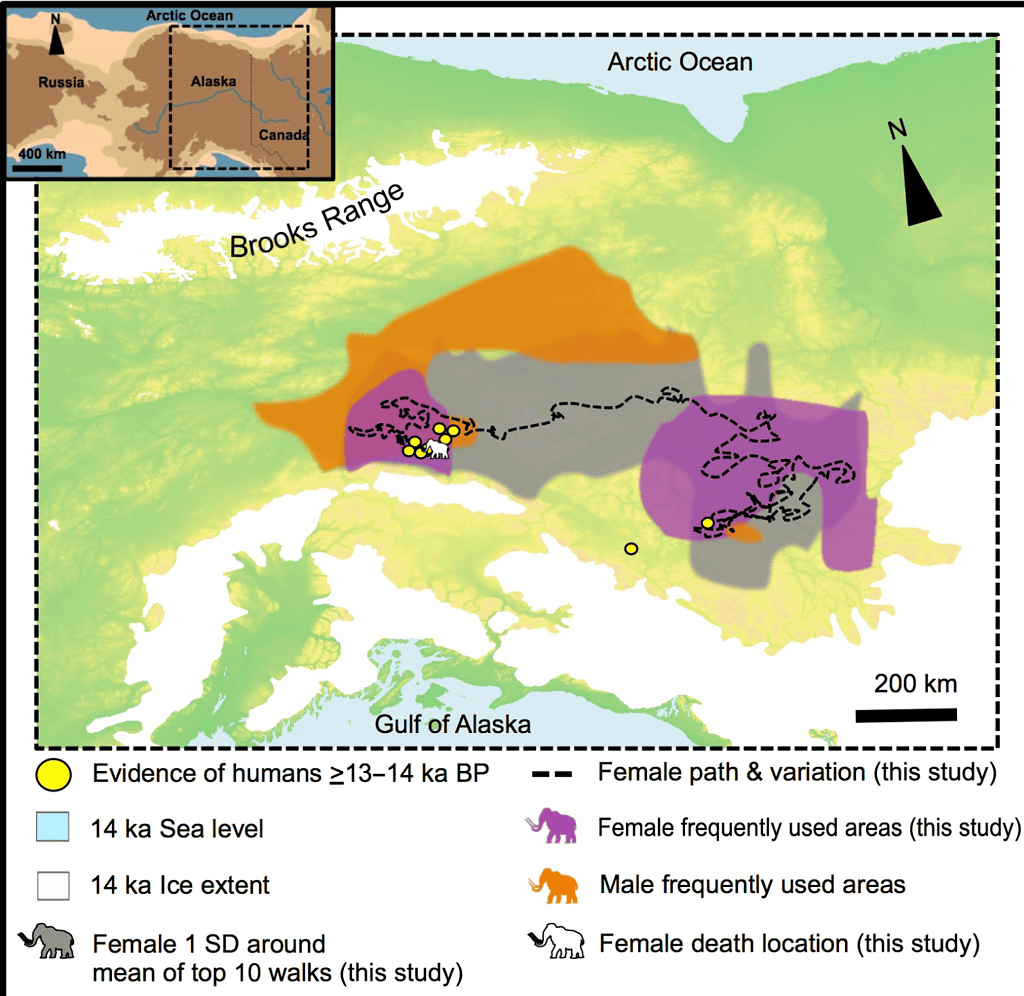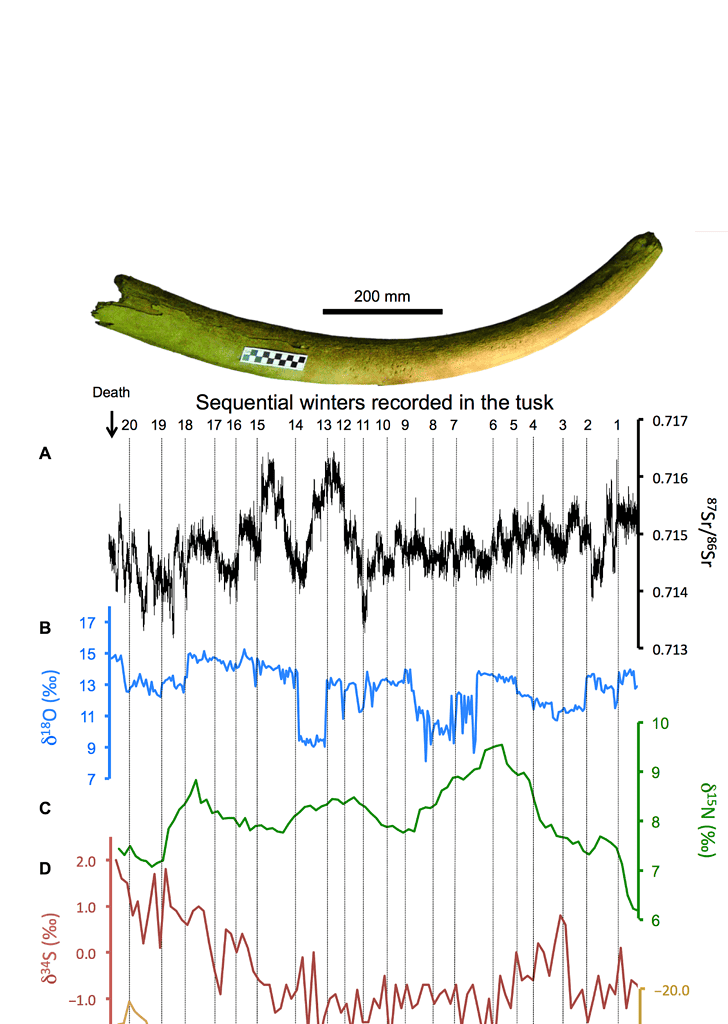Élmayuujey’eh, or Elma for short, was born in what is now the Canadian Yukon province some 14,000 years ago. She spent the first few years of her life there and then undertook a stunning journey across the frozen land, going all the way to eastern Alaska — where she met an untimely end at the hands of human hunters.
But researchers can figure out an important part of her story from a complete tusk discovered at Swan Point, one of the oldest archaeological sites in the Americas. In fact, Élmayuujey’eh (whose name translates to “hella lookin” in the aboriginal Kaska language) can help us understand a lot about both mammoths and early humans in the Americas.

Wooly mammoths are an iconic species. They roamed across vast, chilly landscapes of Europe, Asia, and North America, surviving in harsh glacial conditions. Their significance extends beyond their biological characteristics: they play a pivotal role in our understanding of prehistoric ecosystems and climate change. The discovery of remarkably well-preserved specimens in permafrost has provided valuable insight into their biology and the environments they inhabited.
But mammoths can also help us understand early human populations through their tusks.
Frigid human resilience
In mainland Alaska, wooly mammoths coexisted with early humans for over a thousand years after the Last Glacial Maximum. However, the details of their interactions with humans remain largely unknown.

The Last Glacial Maximum, occurring around 20,000 years ago, represents the peak of the last Ice Age. During this time, global temperatures were significantly lower, sea levels were much lower, and vast areas that are now temperate were covered in ice and tundra. This period was crucial in shaping the Earth’s current geography, but it was a trying period for everyone on Earth.
With vast areas covered in ice and permafrost and a much colder climate, resources were very limited. Food sources were scarce as the glacial landscape supported fewer plants and animals, vital for human sustenance and survival. These challenging conditions demanded remarkable adaptability and innovation from early humans, as they had to develop new survival strategies, tools, and techniques to cope with the severe climate and limited resources, laying important foundations for human resilience and ingenuity.
For these struggling human populations, hunting mammoths was a major boon. In fact, mammoths seem to be so important for early humans that camps were made to follow mammoth migrations. Elma’s tusk was discovered alongside the remains of two related juvenile mammoths and butchered remains of other game, along with evidence of campfires and the use of stone tools. This discovery “indicates a pattern consistent with human hunting of mammoths,” said Ben Potter, an archaeologist and professor of anthropology at the University of Alaska Fairbanks (UAF).
A long trek
Elma was a healthy mammoth, but that didn’t help her much when the human hunters targeted her. She undertook a journey of over 1,000 km (620 miles), and much of this journey overlaps with a mammoth who lived 3,000 years earlier. This shows that the migration and movement patterns of mammoths were pretty consistent over thousands of years.
Researchers are able to track the movements of mammoths so well due by using isotopic studies.
Mammoth tusks are exceptionally well-suited for isotopic studies due to several unique characteristics. Mammoth tusks grew in layers. This incremental growth pattern captures a chronological record of the mammoth’s life, much like tree rings do for trees. It allows scientists to analyze different life stages of the animal, from years to even seasons.
The tusks effectively preserve chemical signatures over thousands of years, incorporating isotopes from the local environment where the mammoth lived and fed. These isotopes remain stable over long periods, providing a reliable record of past environmental conditions and the mammoth’s diet and migration.
The isotopic composition in a tusk can vary based on factors like local geology, vegetation, and water sources. By analyzing these variations, researchers can infer a range of ecological and biological information, including the mammoth’s migration patterns, changes in diet, and even climate conditions of different regions it inhabited.

Human boon, mammoth nightmare
For Elma, life wasn’t easy, but she was doing well. But when the humans also came in, it was too much.
“She was a young adult in the prime of life. Her isotopes showed she was not malnourished and that she died in the same season as the seasonal hunting camp at Swan Point where her tusk was found,” said senior author Matthew Wooller, who is director of the Alaska Stable Isotope Facility and a professor at UAF’s College of Fisheries and Ocean Sciences.
Ultimately, it was a double-whammy that sent mammoths to extinction. Both humans and shifting climates contributed to the downfall of these iconic creatures.
“Climate change at the end of the ice age fragmented mammoths’ preferred open habitat, potentially decreasing movement and making them more vulnerable to human predation,” Potter said.
The fact that we can figure out so much from so little is remarkable. The story of wooly mammoths — like the story of early humans — is a complex one, but we’re slowly understanding more and more.
Journal Reference: Audrey Rowe et al, A female woolly mammoth’s lifetime movements end in an ancient Alaskan hunter-gatherer camp, Science Advances (2024). DOI: 10.1126/sciadv.adk0818. www.science.org/doi/10.1126/sciadv.adk0818






